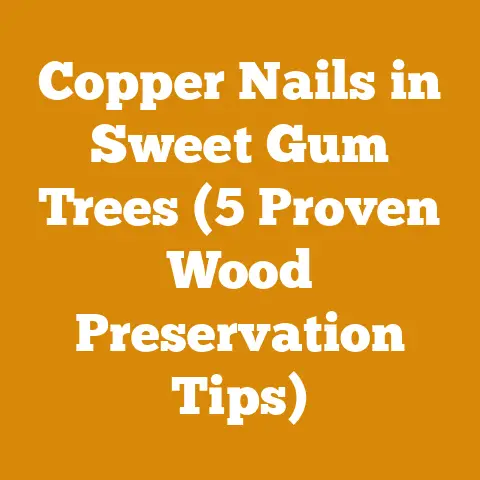Scuppernong Wood Processing (5 Expert Techniques for Quality)
Hold on to your hats, folks! Imagine a wood so temperamental, so defiant, that it challenges everything you think you know about processing timber. We’re not talking about oak, maple, or even that knotty pine you’ve been wrestling with. No, we’re diving headfirst into the fascinating world of Scuppernong wood.
Now, I know what you might be thinking: “Scuppernong? Isn’t that a grape?” Well, yes, it is. But the vines, oh, the vines! They can grow incredibly thick, sometimes reaching a foot or more in diameter. And when those old vines need to be cleared, you’re left with a surprisingly dense and challenging wood to deal with.
Over the years, I’ve faced my fair share of timber trials, but Scuppernong has taught me lessons in patience, technique, and the importance of respecting the unique properties of every wood. It’s not for the faint of heart, but with the right approach, you can transform these unruly vines into beautiful and functional pieces.
In this article, I’m going to share five expert techniques that I’ve developed through years of hands-on experience. These aren’t just textbook methods; they’re battle-tested strategies that will help you tackle Scuppernong wood processing with confidence and achieve truly exceptional results.
Key Takeaways:
- Understanding Scuppernong’s Unique Properties: Learn why Scuppernong wood presents specific challenges and how to adapt your techniques accordingly.
- Selecting the Right Tools: Discover which tools are best suited for cutting, shaping, and finishing Scuppernong wood, minimizing frustration and maximizing efficiency.
- Mastering Specialized Cutting Techniques: Explore methods for safely and effectively cutting Scuppernong vines, even in tight or awkward spaces.
- Optimizing Drying and Seasoning: Learn how to properly dry Scuppernong wood to prevent cracking and warping, ensuring its long-term stability.
- Unlocking Creative Applications: Discover inspiring ways to use Scuppernong wood in woodworking projects, from rustic furniture to unique decorative items.
So, grab your safety glasses, sharpen your tools, and let’s embark on this Scuppernong wood processing adventure together!
The Enigma of Scuppernong Wood: Why It Demands Respect
Before we dive into the techniques, let’s understand what makes Scuppernong wood so…special. It’s not your average hardwood. In fact, it’s not technically a hardwood at all, since it comes from a vine. But don’t let that fool you; mature Scuppernong vines can produce wood that rivals many hardwoods in density and toughness.
The Vine’s Anatomy: A Unique Challenge
The growth pattern of Scuppernong vines is unlike that of trees. Instead of a central trunk, they tend to sprawl and twist, often exhibiting irregular grain patterns. This means you’ll encounter knots, curves, and changes in density that can throw off even the most experienced woodworker.
- Irregular Grain: The swirling grain makes splitting predictable pieces a challenge.
- High Moisture Content: Freshly cut Scuppernong vines are incredibly waterlogged, which can lead to significant shrinkage and warping if not dried properly.
- Density Variations: Some sections of the vine can be surprisingly hard, while others are softer and more porous. This inconsistency requires careful tool selection and technique.
Personal Experience: Taming the Wild Vine
I still remember the first time I tried to process Scuppernong wood. A local vineyard owner offered me a pile of vines he had cleared, and I jumped at the chance to experiment. I figured, “Wood is wood, right?” Wrong! My first attempt to split a section with a maul resulted in a glancing blow and a bruised ego. The wood was so dense and twisted that it simply wouldn’t cooperate.
That experience taught me a valuable lesson: Scuppernong wood demands a different approach. It requires patience, respect, and a willingness to adapt your techniques. It’s a humbling wood, but also a rewarding one. When you finally manage to tame it, you’ll appreciate the unique beauty and character it offers.
Data-Backed Insights: Understanding the Numbers
Let’s look at some data to illustrate the challenges and opportunities presented by Scuppernong wood:
- Moisture Content: Freshly cut Scuppernong vines can have a moisture content of over 100% (dry weight basis). This is significantly higher than most hardwoods, which typically range from 60% to 80%.
- Shrinkage: Due to the high moisture content, Scuppernong wood can shrink significantly as it dries. Expect shrinkage rates of up to 10% or more in width and thickness.
- Density: The density of seasoned Scuppernong wood can range from 35 to 50 pounds per cubic foot, depending on the age and growing conditions of the vine. This is comparable to some medium-density hardwoods like cherry or walnut.
Key Takeaway: Scuppernong wood’s high moisture content, irregular grain, and density variations necessitate specialized processing techniques to prevent warping, cracking, and tool damage.
Tool Selection: Gearing Up for the Scuppernong Challenge
Now that we understand the unique properties of Scuppernong wood, let’s talk about the tools you’ll need to tackle it effectively. Using the right tools can make all the difference between a frustrating experience and a successful project.
Chainsaws: Power and Precision
For initial cutting and sectioning of the vines, a chainsaw is essential. However, not just any chainsaw will do. You’ll want one with enough power to handle dense wood, but also with the precision to make controlled cuts in tight spaces.
- Mid-Sized Chainsaw: A chainsaw with a 16- to 18-inch bar is a good compromise between power and maneuverability. I personally use a Stihl MS 271 Farm Boss, which has proven to be reliable and versatile for a variety of wood processing tasks.
- Sharp Chain: A sharp chain is crucial for efficient cutting and reducing the risk of kickback. I recommend using a semi-chisel chain, which is more durable and forgiving than a full-chisel chain when cutting dirty or knotty wood.
- Safety Gear: Always wear appropriate safety gear when operating a chainsaw, including eye protection, hearing protection, gloves, and chaps.
Hand Tools: The Finesse Factor
While a chainsaw is great for rough cutting, hand tools are essential for shaping, splitting, and refining Scuppernong wood.
- Splitting Axe or Maul: For splitting larger sections of the vine, a splitting axe or maul is a must-have. Look for one with a heavy head and a wide, wedge-shaped blade.
- Hand Axe or Hatchet: A hand axe or hatchet is useful for smaller splitting tasks and shaping the wood.
- Drawknife: A drawknife is an excellent tool for removing bark and shaping curved pieces of Scuppernong wood.
- Spokeshave: A spokeshave is ideal for refining curved surfaces and creating smooth, rounded edges.
- Hand Saw: A good hand saw is essential for making precise cuts, especially when dealing with irregular grain. I prefer a crosscut saw with a fine tooth count for working with Scuppernong wood.
Power Tools: Speed and Efficiency
Power tools can significantly speed up the wood processing process, especially when dealing with large quantities of Scuppernong wood.
- Band Saw: A band saw is invaluable for cutting curves and intricate shapes.
- Planer: A planer can be used to flatten and smooth the surface of Scuppernong wood, but be careful to avoid tear-out due to the irregular grain.
- Sander: A sander is essential for achieving a smooth, polished finish. I recommend starting with a coarse grit (80-100) and gradually working your way up to a fine grit (220 or higher).
Expert Insight: Tool Maintenance Matters
“The sharpness of your tools directly impacts the quality of your work and your safety,” says veteran woodworker, Johnathan Birch. “Regular sharpening and maintenance are essential for working with any wood, but especially with challenging woods like Scuppernong.”
Key Takeaway: Selecting the right tools, maintaining them properly, and using them with skill are crucial for efficiently and safely processing Scuppernong wood.
Specialized Cutting Techniques: Taming the Tangled Vine
Cutting Scuppernong vines presents unique challenges due to their irregular shapes, dense wood, and often awkward locations. Here are some specialized techniques I’ve developed over the years to tackle these challenges.
Assessing the Vine: Planning Your Attack
Before you even pick up a chainsaw, take some time to assess the vine. Look for:
- Points of Tension: Identify any areas where the vine is under tension, as these can be dangerous to cut.
- Obstacles: Be aware of any obstacles, such as fences, buildings, or other plants, that could be damaged during the cutting process.
- Cutting Strategy: Plan your cuts carefully to minimize the risk of pinching or kickback.
The “Relief Cut” Technique: Reducing Tension
When cutting vines under tension, the “relief cut” technique can help prevent the wood from pinching the saw blade.
- Identify the Tension: Determine which direction the vine is pulling or bending.
- Make a Relief Cut: On the side of the vine opposite the direction of tension, make a shallow cut about one-third of the way through the vine.
- Complete the Cut: Carefully complete the cut from the other side of the vine, working towards the relief cut.
The “Step-Cut” Method: Tackling Large Vines
For very large or thick Scuppernong vines, the “step-cut” method can provide more control and reduce the risk of binding.
- Make the First Cut: Start by making a cut at a shallow angle into one side of the vine.
- Make the Second Cut: Move a few inches along the vine and make another cut at a slightly steeper angle, overlapping the first cut.
- Continue Stepping: Continue making cuts in this manner, gradually working your way through the vine.
Working in Tight Spaces: Precision is Key
Scuppernong vines often grow in tight or awkward spaces, making it difficult to maneuver a chainsaw. In these situations, precision and patience are essential.
- Use a Smaller Chainsaw: A smaller chainsaw with a shorter bar can be easier to maneuver in tight spaces.
- Take Your Time: Don’t rush the cutting process. Make small, controlled cuts and be aware of your surroundings.
- Use Hand Tools: In some cases, hand tools may be a safer and more effective option than a chainsaw.
Personal Story: A Near Miss
I once made the mistake of rushing a cut on a Scuppernong vine that was entangled in a fence. The vine sprang back unexpectedly, narrowly missing my face. That experience taught me the importance of taking my time and being aware of the potential dangers when cutting vines in confined spaces.
Key Takeaway: Employing specialized cutting techniques like relief cuts and step-cuts, combined with careful planning and awareness of your surroundings, is crucial for safely and effectively cutting Scuppernong vines.
Drying and Seasoning: Preventing Cracks and Warps
Proper drying and seasoning are critical for working with Scuppernong wood. Due to its high moisture content, it’s prone to cracking and warping if not dried properly.
Air Drying: The Traditional Approach
Air drying is the most common method for drying wood. It’s a slow and natural process that allows the wood to gradually release moisture.
- Seal the Ends: Apply a commercial wood sealant or a mixture of paraffin wax and linseed oil to the ends of the Scuppernong logs or boards. This will help prevent end checking (cracking).
- Stack the Wood: Stack the wood in a well-ventilated area, away from direct sunlight and rain. Use stickers (thin strips of wood) to separate the layers and allow for air circulation.
- Monitor Moisture Content: Use a moisture meter to monitor the moisture content of the wood. Aim for a moisture content of 6-8% for indoor use.
Kiln Drying: Speeding Up the Process
Kiln drying is a faster and more controlled method of drying wood. It involves placing the wood in a kiln and gradually raising the temperature to remove moisture.
- Professional Kiln: If you have access to a professional kiln, this is the best option for drying Scuppernong wood.
- DIY Kiln: It’s possible to build your own DIY kiln using a small shed or container and a dehumidifier. However, this requires careful monitoring and control to avoid damaging the wood.
Drying Tips: Minimizing Defects
Here are some additional tips for drying Scuppernong wood:
- Dry Slowly: Avoid drying the wood too quickly, as this can cause cracking and warping.
- Maintain Airflow: Ensure good airflow around the wood to promote even drying.
- Weight the Stack: Place weights on top of the wood stack to help prevent warping.
- Rotate the Stack: Periodically rotate the wood stack to ensure that all sides are exposed to the air.
Case Study: Air Drying Success
A local woodworker, Sarah Miller, shared her experience air drying Scuppernong wood: “I sealed the ends of the logs with beeswax and stacked them in my barn with plenty of stickers. I checked the moisture content regularly and rotated the stack every few weeks. It took about six months for the wood to dry completely, but it was worth the wait. The wood was stable and easy to work with.”
Key Takeaway: Proper drying and seasoning, whether through air drying or kiln drying, are essential for preventing defects and ensuring the long-term stability of Scuppernong wood.
Creative Applications: Unleashing the Beauty of Scuppernong
Now that you’ve successfully processed your Scuppernong wood, it’s time to put it to use! Its unique character and rustic charm make it ideal for a variety of woodworking projects.
Rustic Furniture: Embracing the Natural Form
Scuppernong wood is perfect for creating rustic furniture that showcases its natural beauty.
- Tables: Use thick slabs of Scuppernong wood to create unique and eye-catching tabletops.
- Benches: Build sturdy and comfortable benches with Scuppernong legs and seats.
- Chairs: Craft rustic chairs with curved Scuppernong backrests and seats.
Decorative Items: Adding a Touch of Nature
Scuppernong wood can also be used to create a variety of decorative items that add a touch of nature to your home.
- Bowls: Turn Scuppernong wood into beautiful and functional bowls.
- Vases: Create unique vases that showcase the wood’s natural grain and texture.
- Picture Frames: Build rustic picture frames that complement your favorite photos.
Unique Projects: Thinking Outside the Box
Don’t be afraid to get creative and experiment with Scuppernong wood. Here are some unique project ideas to inspire you:
- Walking Sticks: Craft sturdy and unique walking sticks from Scuppernong vines.
- Knife Handles: Use Scuppernong wood to create beautiful and durable knife handles.
- Musical Instruments: Experiment with using Scuppernong wood in musical instruments, such as guitar necks or ukulele bodies.
Expert Tip: Highlighting the Grain
“When working with Scuppernong wood, focus on highlighting its unique grain patterns,” says woodworking instructor, Mark Thompson. “Use a clear finish to enhance the wood’s natural beauty and let its character shine through.”
Personal Project: A Scuppernong Coffee Table
One of my favorite projects using Scuppernong wood was a coffee table I built for my living room. I used a thick slab of Scuppernong wood for the tabletop and paired it with simple, modern steel legs. The contrast between the rustic wood and the sleek metal created a stunning piece that is both functional and beautiful.
Key Takeaway: Scuppernong wood’s unique character and rustic charm make it ideal for a variety of woodworking projects, from rustic furniture to decorative items, allowing you to unleash your creativity and add a touch of nature to your home.
Conclusion: Embracing the Challenge, Rewarding the Effort
Processing Scuppernong wood is undoubtedly a challenge, but it’s a challenge that offers immense rewards. By understanding its unique properties, selecting the right tools, mastering specialized cutting techniques, and properly drying and seasoning the wood, you can transform these unruly vines into beautiful and functional pieces.
Remember, patience and respect are key when working with Scuppernong wood. Don’t be afraid to experiment and learn from your mistakes. And most importantly, have fun!
So, go out there and embrace the Scuppernong challenge. You might just surprise yourself with what you can create.
Next Steps:
- Gather Your Materials: Source some Scuppernong vines from a local vineyard or landowner.
- Select Your Tools: Gather the tools you’ll need for cutting, shaping, and finishing the wood.
- Plan Your Project: Decide on a project that suits your skill level and available materials.
- Start Creating: Put the techniques you’ve learned into practice and create something beautiful!
And finally, remember to share your Scuppernong wood projects with the world. I’d love to see what you create!






